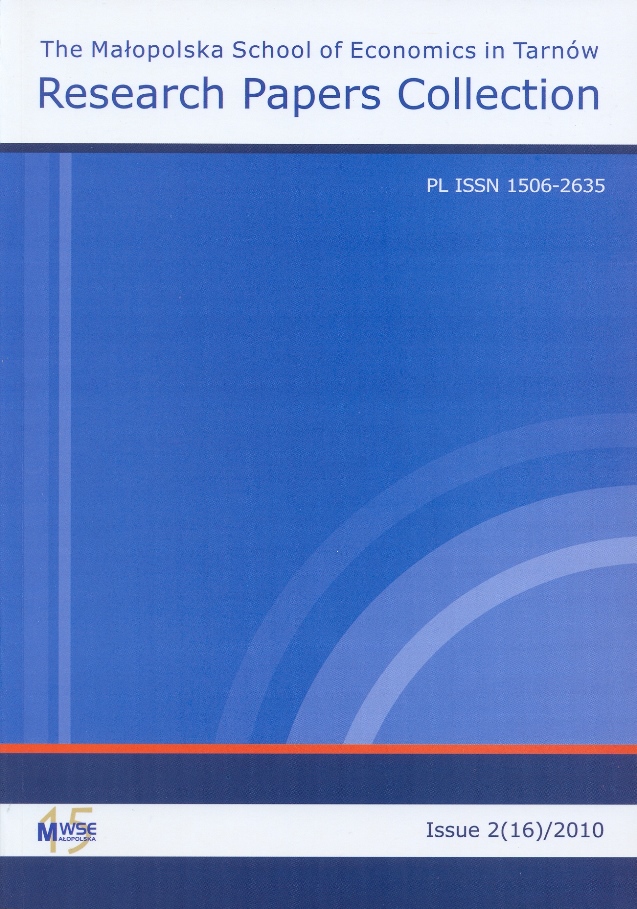Abstract
What is the adequate size of credit for a given economy? What variables are essential in order to solve this problem? A solution of this task points to variables: the volume of compensations, the real labour productivity ratio, and the percentage of pays changed into bank deposits. These three categories determine the maximum value of credit, and this size does not boost inflation. However, compensations should be in accord with the amount of employees—the human capital. Considerations and computations presented here are in tune with perceiving capital as an abstract category of the capacity of doing work, and money as work receivables as discussed in the earlier papers. Considering the triad: capital—labour—money is the key for finding the solution of the agenda. In addition, the accurate concept of capital leads to an innovative interpretation of the economic matters. In the paper the solution of the problem is introduced as a part of theoretical clarification of the open source currency economic system.
References
Cieślak I., Dobija M. 2007. “Teoretyczne podstawy rachunkowości kapitału ludzkiego”. Zeszyty Naukowe, no. 735. Kraków: Akademia Ekonomiczna.
View in Google Scholar
Dobija M. 2001. “Human resource costing and accounting as a determinant of minimum wage theory”. Zeszyty Naukowe, no. 553. Krakow: Akademia Ekonomiczna.
View in Google Scholar
Dobija M. 2005. “Financing labour in the public sector without tax funds”. Argumenta Oeconomica Cracoviensia, no. 4.
View in Google Scholar
Dobija M. 2007. “Abstract nature of capital and money”. In: New developments in banking and finance. Ed. L.M. Cornwall. Chapter 4, pp. 89–114. New York: Nova Science Publishers. ISBN 1-60021-576-9.
View in Google Scholar
Dobija M. 2008. “Labour productivity ratio and international comparison of economic performance—formalization of the PPP theory and preliminary examination”. EMERGO, no. 1.
View in Google Scholar
Dobija M. 2009a. “Produktywność pracy a rozmiar sektora publicznego”. Master of Business Administration, no. 1 (96), January–February.
View in Google Scholar
Dobija M. 2009b. “Fundamentalne przyczyny kryzysów finansowych”. Zeszyty Naukowe Małopolskiej Wyższej Szkoły Ekonomicznej w Tarnowie, no. 2 (13), vol. 1.
View in Google Scholar
Dobija M. 2010. “Economics in harmony with the fundamental principles”. In: Enterprise in the face of challenges of the 21th Century economy. Ed. R. Borowiecki. Toruń: Towarzystwo Naukowe Organizacji i Kierownictwa. ISBN 978-83-7285-509-1.
View in Google Scholar
Duwendag D. et al. 1995. Teoria pieniądza i polityka pieniężna. Transl. by R. Kokoszczyński. Warszawa: Poltex. ISBN 83-85366-80-6.
View in Google Scholar
Galbraith J. K. 1982. Pieniądz pochodzenie i losy. Transl. by S. Rączkowski. Warszawa: Państwowe Wydawnictwo Ekonomiczne.
View in Google Scholar
Garrison R. W. 2001. Time and money: The macroeconomics of capital structure. London: Routledge. ISBN 0415079829.
View in Google Scholar
Greco T. Jr. 2001. Money: Understanding, and creating alternatives to legal tender. Chelsea Green Publishing Company. ISBN 1890132373.
View in Google Scholar
Główny Urząd Statystyczny. 2009. Wyniki finansowe banków w 2008 r. Informacje bieżące. Wyniki wstępne. Warszawa.
View in Google Scholar
Hodgson Brown E. 2007. The web of debt: The shocking truth about our money system and how we can break free. Third Millenium Press. ISBN 978-0-9795608-1-1.
View in Google Scholar
Lietaer B. 2001. The future of money: Beyond greed and scarcity. London: Random House. ISBN 0712683992.
View in Google Scholar
Luchinger R. 2007. 12 ikon ekonomii; od Smitha do Stiglitza. Transl. by J. Miron. Warszawa: Wydawnictwo Studio EMKA. ISBN 978-83-60652-18-3.
View in Google Scholar
Polanyi K., Arensberg K., Pearson H. 1957. Trade and market in the early empires. New York: The Free Press.
View in Google Scholar
Rushkoff D., 2008. “Waluta open source”. In: Niebezpieczne idee we współczesnej nauce. Ed. J. Brockman. Sopot: Smak Słowa. ISBN 978-83-925897-3-0.
View in Google Scholar
Schmandt-Besserat D. 1988. Accounting in prehistory. 5th World Congress of Accounting Historians. Sydney.
View in Google Scholar
Schmandt-Besserat D. 2007. Jak powstało pismo. Warszawa: Wydawnictwo AGADE. ISBN 978-83-87111-38-0.
View in Google Scholar
Struve V.V., 1969. “Some new data on the organisation of labour and on social structure in Sumer during the reign of the III rd Dynasty of Ur”. In: Ancient Mesopotamia. Moskwa: Nauka.
View in Google Scholar
Śliwa M., Dobija M. 2001. “Money as an intellectual venture”. In: Intellectual product and intellectual capital. Ed. S. Kwiatkowski, Ch. Stowe Warszawa: Wydawnictwo Akademii im. Leona Koźmińskiego. ISBN 83-86846-65-8.
View in Google Scholar
Wicksteed Ph. H. 1984. An essay on the contribution of the laws of distribution. 1932 edition. Reprint no. 12. London: London School of Economics. (1999 electronic edition.)
View in Google Scholar
© Copyright by Małopolska School of Economics in Tarnów. The articles are available under the Creative Commons Attribution NonCommercial-NoDerivatives 4.0 International License


